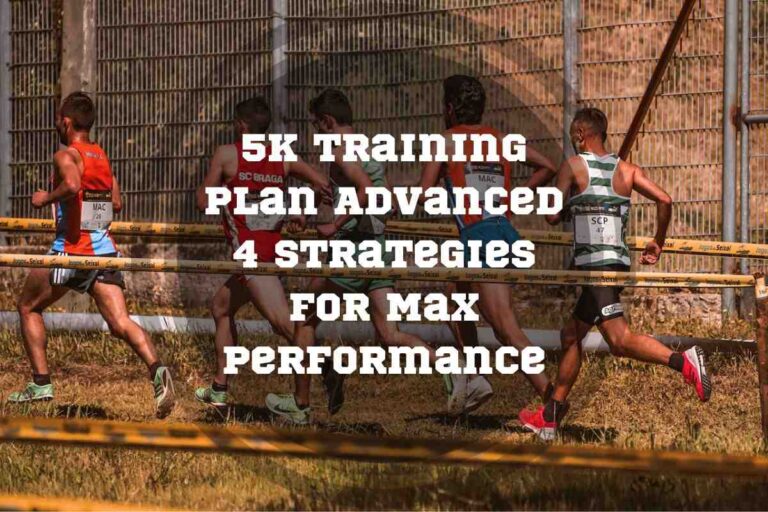Threshold Running: 4-Week Training Plan + 3 Top Exercises
Are you looking to improve your race times? Threshold running is a great technique to improve your endurance, speed, and stamina. In this article, you will learn how to use threshold running techniques in your workouts to improve your running potential.
What is a threshold in running?
The threshold is considered the tipping point wherein your body has to start producing energy without oxygen through the metabolic pathway known as glycolysis rather than through aerobic metabolism. Threshold running is basically training at a pace just below this threshold to improve your overall performance.
What Is Threshold Running?
Threshold running involves running at or near your lactate threshold. The lactate threshold is the point during exhaustive exercise at which the lactate builds up in the bloodstream faster than the body can remove it.
There are two main types of threshold running:
1. Continuous Threshold Runs
Runners maintain a steady pace just below their lactate threshold for an extended period of time. This can last anywhere from 20 minutes to an hour or more depending on your fitness level.
2. Interval Threshold Runs
Runners alternate between running at their threshold and taking short breaks for recovery. For example, they do 3-5 minutes of running at a threshold pace, followed by a quick rest.

What is the Threshold Running Pace?
May people wonder what is threshold pace? This refers to the speed at which a runner can maintain their pace just below the lactate threshold. This pace is usually hard, as the runner is exerting a significant effort, but it can be sustained for a prolonged period of time.
The greatest quantity of oxygen that a person’s body can consume when exercising is called their VO2 max. Every person has a different level of VO2 max. After you have taken a VO2 max test, your lactate threshold occurs around 88-93% of your VO2 max, so your threshold running pace would be the pace you are running at 88-93% of your VO2 max according to your lab results.
3 Benefits of Threshold Running
Using threshold running in your training routine can help you in many ways. Here are some benefits of threshold running:
1. Increases Your Oxygen Intake
Threshold running helps your body get comfortable with increased oxygen demand, which helps your body produce more energy and deliver more oxygen throughout the body.
2. Makes You More Efficient at Clearing Lactate
Training at the lactate threshold helps your body to clear the lactic acid efficiently from your muscles. This results in your body being able to sustain intense workouts for a longer period of time before experiencing fatigue.
3. Boosts Your Mental Health
Threshold running can often be painful, which teaches you to push through discomfort and maintain a strong effort. It can strengthen your mental resilience so that you can endure and overcome challenges during races.
What Is the Lactate Threshold?
The lactate threshold is the level of exercise intensity where lactate production exceeds lactate clearance, causing the concentration of lactate in the blood to rise quickly.
In order to find the lactate threshold pace for running, we use a threshold pace calculator. Firstly, divide your time by the distance you have covered to obtain your average pace for that distance. For example:
If you run 5K, multiply that average pace by 1.07. If you run 10K, multiply the average pace over the 10K by 1.01. Once you have the numbers, you can then use the automatic calculator to put in the values and it will provide you with the threshold pace.
On average, non-athletes reach the lactate threshold at 50-60% of their VO2 max, recreational athletes reach the lactate threshold at about 65-80% of their VO2 max, and elite athletes reach the lactate threshold at 85-95% of VO2 max.
How to Determine Threshold Running Pace
If you are wondering how to calculate threshold pace, here are two tips to help you do so:
1. Run a Time Trial
First, you need to find a flat running course of around two to three miles in length. Then, you must begin with a warmup of approximately 10 minutes, in which you can either jog lightly or do some dynamic stretches.
Pro Tip:
Start the time trial. Run faster than usual, aiming to maintain the same effort throughout the run. It’s always best to increase your pace gradually at the start, as increasing your pace too quickly can lead to inaccurate results.
Finally, record your finish time and then calculate your average pace per mile. This average pace is your lactate threshold pace.
2. Using pace calculators
Another way of finding your threshold running pace is by using threshold pace calculators.
Threshold pace is basically the same as your running pace, however, the only difference is that it is calculated when your heart rate has reached from a range of 71% to 85% of running pace.
So firstly, you need to plug your result for the 5K or 10K or other distance into a calculator to determine an equivalent running performance. Next, you can take the average pace of the distance you are going to run at around 80% of this pace. This number will be your average threshold running pace for the chosen distance.
Subscribe to Our Running Newsletter!
Get free running tips from renowned professional athletes and discounts from top-notch brands.
How to Perform Threshold Runs Correctly
Threshold runs can be great for endurance, but only if performed correctly. Follow these guidelines to use threshold running effectively.
1. Find Your Threshold Pace
In order to perform threshold runs effectively, you need to find your threshold pace. From this, you can formulate a focused training plan to improve your lactate threshold.
2. Increase Your Training Slowly
As discussed earlier, threshold runs are quite hard, so you should increase these runs slowly, listening to your body as you do so. It’s best to start with small runs, such as 20-30 minutes. Once you become comfortable with this length, you can increase the runs gradually.
How to Improve Threshold Jogging Results: 4-Week Training Plan and 3 Useful Exercises
To improve threshold jogging results, it’s best to have a structured training plan. Here’s a sample plan for a month:
Week 1
| Days | Workout | Time |
|---|---|---|
| Monday | Easy Jog | 30 minutes |
| Tuesday | Threshold Run | 20 minutes |
| Wednesday | Rest or Cross-Training | |
| Thursday | Interval Training | Five sets of 400m intervals with two minutes of rest in between |
| Friday | Easy Jog | 30 minutes |
| Saturday | Long Run | 20 minutes |
| Sunday | Rest |
Week 2
| Days | Workout | Time |
|---|---|---|
| Monday | Easy Jog | 30 minutes |
| Tuesday | Threshold Run | 25 minutes |
| Wednesday | Rest or Cross-Training | |
| Thursday | Interval Training | Five sets of 800m intervals with two minutes of rest in between |
| Friday | Easy Jog | 30 minutes |
| Saturday | Long Run | 70 minutes |
| Sunday | Rest |
Week 3
| Days | Workout | Time |
|---|---|---|
| Monday | Easy Jog | 30 minutes |
| Tuesday | Threshold Run | 30 minutes |
| Wednesday | Rest or Cross-Training | |
| Thursday | Interval Training | Five sets of 1,000m intervals with two minutes of rest in between |
| Friday | Easy Jog | 30 minutes |
| Saturday | Long Run | 80 minutes |
| Sunday | Rest |
Week 4
| Days | Workout | Time |
|---|---|---|
| Monday | Easy Jog | 30 minutes |
| Tuesday | Threshold Run | 35 minutes |
| Wednesday | Rest or Cross-Training | |
| Thursday | Interval Training | Five sets of 1,200m intervals with two minutes of rest in between |
| Friday | Easy Jog | 30 minutes |
| Saturday | Long Run | 90 minutes |
| Sunday | Rest |
In addition to a training plan, a number of different exercises can also help increase your jogging results. Here are some exercises to consider:
1. Hill Repeats
Find a comfortable hill with few bumps and great traction. Start running up the hill at a higher effort level than normal and then swiftly jog back down.

2. Tempo Runs
In these runs, you run at a fast pace for longer periods of time so that you can increase your endurance. Once you become good at a certain duration, start increasing it gradually.
3. Fartlek Training
This training involves bursts of speed and intensity during your runs. You alternate between faster and slower paces for different intervals of time to teach your body how to delay lactate fatigue.
Frequently Asked Questions About Threshold Running
Tempo vs Threshold Run: What Is the Difference?
Threshold running involves running at or just below your current threshold level, while tempo running involves running slightly slower than your threshold level, but for a longer distance than a threshold run.
Is it good to run at a threshold pace?
Running at a threshold pace can improve your fitness and performance. It does so by increasing your lactate threshold, which enables you to sustain a faster pace for longer.
What is a good threshold heart rate?
The threshold heart rate varies from person to person. It is typically between 80 and 90 percent of your maximum heart rate.
Final Tips for Threshold Running
To sum up, threshold running improves your ability to produce energy without having lactate build-up in your muscles. It trains your body to handle faster paces without producing the metabolic byproducts that make your muscles sore. So, take your running to the next level with threshold running.
Also read:
- Groin Pain in Runners
- Numb Toes When Running
- Running in 100 Degree Weather
- Best Cold Weather Running Gloves
- Running With Glasses
- What to Wear Running in 50 Degree Weather
- Best Running Rain Jackets
- How to Carry Water While Running
- 5k Training Plan Advanced
- Benefits of Sprinting
Refegrences:
- What to Know About VO2 Max // WebMD: https://www.webmd.com/fitness-exercise/what-to-know-about-vo2-max/
- Velocity at Lactate Threshold and Running Economy Must Also be Considered Along With Maximal Oxygen Uptake When Testing Elite Soccer Players During Preseason // University of Nebraska at Omaha: https://digitalcommons.unomaha.edu/cgi/viewcontent.cgi?article=1153&context=biomechanicsarticles
- Lactate Threshold Testing // University of Virginia School of Medicine: https://med.virginia.edu/exercise-physiology-core-laboratory/fitness-assessment-for-community-members/lactate-threshold-testing/
- Effects of Running-Specific Strength Training, Endurance Training, and Concurrent Training on Recreational Endurance Athletes’ Performance and Selected Anthropometric Parameters // MDPI: https://www.mdpi.com/1660-4601/19/17/10773
- Equivalent Running Performances Calculator // Alp Fitness: https://alpfitness.com/fitness-calculators/calculate-equivalent-running-performances/
If you have any questions or suggestions, you can contact us via email – [email protected]






